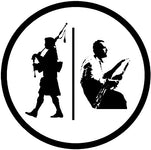
Ceol Tíre 1981 - The Irish Warpipes
Information is based on the newsletter from the Folk Music Society of Ireland, November 1981.
The Irish Warpipes: A Journey Through History
Ireland's rich musical heritage boasts many unique and captivating instruments, among which the Irish warpipes stand out for their powerful presence and historical significance. These mouth-blown bagpipes, once integral to Ireland's cultural and martial life, have a fascinating story that has resonated through the centuries.
Origins and Functions
Throughout history, various cultures, particularly those with outdoor or nomadic lifestyles, have developed loud and arresting musical instruments for communication, entertainment, intimidation, and ritual. For the Irish, the warpipes fulfilled this role. This now-extinct form of the bagpipe was prominent from medieval times until the early 19th century.
Historical References and Misunderstandings
Sean Donnelly, a noted player of both war and Uilleann pipes, has delved into the history of the warpipes in Ireland. His research, presented at a meeting of the Folk Music Society of Ireland, sheds light on this intriguing instrument. Donnelly points out that many historical texts refer to an instrument called the "cuisle," often mistranslated as "bagpipe." Initially, cuisle described a quiet, sweet, and soothing pipe, but by the 16th century, the term had evolved to mean "battle pipe" (cuisle catha), reflecting its new, more robust role in warfare.
The Warpipes in Irish Society
References to warpipes become more prevalent from the 16th and 17th centuries, primarily in military contexts. Irish pipers played significant roles in battles, both on the continent and at home. For instance, they were notable at the siege of Boulogne in 1544. At home, pipers led war parties and cattle raids, often accompanied by drums. This period also saw the warpipes used in funerals, dances, sports events, and various other social gatherings.
An engraving from John Derricke’s *Image of Irelande*, dated 1581, depicts pipers in these martial roles, underscoring their importance in Irish culture at the time. Additionally, Elizabethan pardons granted to pipers involved in wars suggest that piping was not confined to specific hereditary families but was a broader cultural practice.
Decline and Revival
By the mid-18th century, distinguishing between references to warpipes and Uilleann pipes becomes challenging. The tradition of the native warpipes appears to have faded around 1800, with the Highland pipes, used by British regiments, becoming more common in Ireland thereafter. The revival of the warpipes in the 1880s and their current use in Ireland are more closely tied to the history of Highland piping than to the original Irish tradition.
Musical Heritage
David Rickard of the Fintan Lalor Pipe Band, interested in reviving and performing Irish warpipe music, provided musical illustrations for Sean Donnelly’s talk. Rickard played traditional pieces such as "The King of Laois," "The Hurlers' March," and the Jacobite tune "The King Enjoys His Own Again," demonstrating the enduring legacy and adaptability of these historical melodies.
Conclusion
The story of the Irish warpipes is a testament to Ireland's dynamic musical history and cultural resilience. From their use in warfare and ritual to their decline and eventual revival, the warpipes reflect the changing tides of Irish society. As researchers like Sean Donnelly and musicians like David Rickard continue to explore and celebrate this rich heritage, the spirit of the warpipes lives on, echoing through the annals of Irish history.
Link to Ceol Tíre Newsletter:
https://folkmusicsocietyofireland.wordpress.com/wp-content/uploads/2012/07/ct20.pdf





Leave a comment